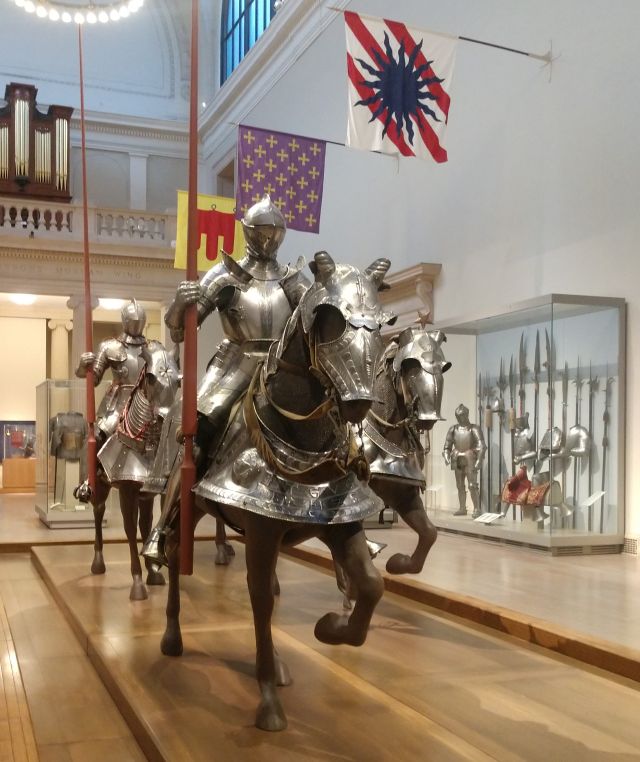A New Monthly Feature
Something occurred to me recently. I write about my dissertation regularly on this blog, but I’ve said little about the actual exhibitions I’ve been researching. I’ve discussed my working process, shared my monthly progress, and described the issues that inform my research. Yet when it comes to the shows themselves, I generally don’t talk about them.
That’s about to change, because from now on I’ll be dedicating a monthly post to these exhibits. I’ll discuss their history, share their contents, and tell you what I think about them. From Egyptian scarabs to American prints, we’ll cover topics as varied as the geographic destinations of the exhibits themselves. And since I was recently in New York, let’s kick off with one of the Neighborhood Circulating Exhibitions, Arms and Armor.

Historical Background
The Neighborhood Circulating Exhibitions were both continuation of Progressive Era reforms and a reaction to anxieties over declining museum attendance and decentralization. Contemporaneous studies such as Paul Marshall Rea’s The Museum and the Community observed that the bigger cities became, the smaller the museum attendance relative to population. As cities expanded and the periphery became more distant from the center, audiences became less likely to travel to visit museums. One popular solution was to bring the museum to these visitors in the form of outreach exhibitions.
The Met initially created the Neighborhood Circulating Exhibitions in consultation with settlement houses, asking their directors what kind of art they would like to see. According to surviving documents, the settlement houses expressed a preference for Egyptian art; Chinese art; and arms and armor. In December of 1933, the Met debuted three traveling shows: Ancient Egypt: Its Life and Art; China and Japan: An Exhibition of the Art of the Far East, and the wordily-titled Arms and Armor, Textiles, and Costume Dolls: An Exhibition of European Art, 1492-1776. The shows visited three sites in lower Manhattan during this first experimental season: University Settlement, Hudson Guild Settlement House, and the Hudson Park branch of the New York Public Library.
After this first season, the Met expanded the program, adding new sites and exhibitions to its schedule. To create some of these new shows, the Met took parts of the original three exhibitions and divided them into smaller installations. This what was happened to the European show. The textile components became European Textiles and Costume Figures, while the armor became, well, Arms and Armor.
What’s in the Exhibition?
Arms and Armor focused on examples from medieval and Renaissance-era Europe. Extant brochures discuss the transition from functional armor intended for battle to more decorative, processional forms associated with jousting. Checklist items included individual helmets or gauntlets as well as full suits. The installation also included guns, swords, and other weapons. The exhibition’s centerpiece was a full-size horse and rider mannequin decked out in full armor.
Compared to some of the other shows featured in the Neighborhood Circulating Exhibitions roster, Arms and Armor doesn’t appear to have circulated as often. European Textiles and Costume Figures, for instance, appeared at least sixteen times at different locations between 1935 and 1941. Arms and Armor, by contrast, only appears in the schedule six to eight times, with most showings happening in 1935 and 1939. It’s possible that there were other showings, but I haven’t seen documentation for them in the archive yet. I suspect it showed up less frequently for a reason. Richard F. Bach, supervisor of the program, said Arms and Armor was the most difficult to move. I don’t blame him. I wouldn’t want to move a fully-armored model horse all that often either.
My Thoughts
Arms and Armor challenged my perception of what is practical or reasonable material for an outreach show. When I started my research, I admittedly had preconceptions about what art museums might include or exclude. I imagined they’d choose small, easily transportable works that weren’t too valuable or significant in case something happened to them. Indeed, I used similar parameters in the outreach work I did in Roswell, with the cutoff point usually being whether I could safely fit the paintings in my car.
Yet as an exhibition Arms and Armor demonstrates that ease of transport is not the sole criterion for outreach curation. Nor is practicality necessarily the most pressing issue. Including high-quality pieces in terms of scale, material, or artist notoriety is also important. These selections challenge the perception that outreach shows are limited to lesser or second-rate material. If anything, shows like Arms and Armor emphasize the importance that museums ascribe to their outreach shows. Their willingness to share rare or significant works from their collection correlates with a belief in the power of these works to transform lives.
Which, I argue, makes it all the more important to study them. After all, museums may believe in the transformative power of these exhibitions, but what about their viewers?
So there you have it. During the 1930s, the Met sent armor out into the city. Next month, we’ll look at a show from a very different initiative: the Community Art Center Project!
Further Reading and Listening
The archivists and curators at the Met have done their own research on this program, which has been invaluable to my work. Check out these links to learn more: